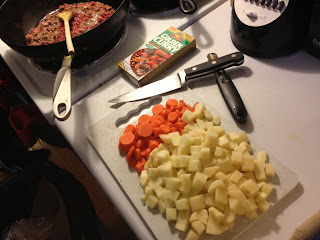When you think of Japanese food, sushi is probably the first thing that comes to mind. Sushi is by far one of my favorite foods, but the cuisine has much more to offer with a variety of influences. カレー or karē is another Japanese classic that I occasionally get a craving for and is way different in concept than sushi. Where sushi is clean and fresh, Japanese rice curry is a big mix of different flavors and ingredients that is a favorite for home cooking.
This dish is essentially a curry stew that you make in a large pot and serve over rice or noodles. It is basically Japanese comfort food because it's warm, spicy and has that stick to your bones feeling. The best part is how easy and quick it is once you can locate some curry blocks.
 |
| Available in multiple heat levels |
The beauty of this dish is the flexibility you have with the ingredients. I personally used potatoes, carrots, and some green pepper I found in my fridge but you can pretty much add any sort of vegetable (celery, peas, broccoli, etc) and use a variety of meats. For this post I just made a curry with ground beef but you can use stew meat or beef cubes. I really recommend at the very least using carrots and potatoes as they are some of them more classic additions. The carrots add a great sweetness and color while the potatoes really gives this dish additional substance and that meat and potatoes status.
Once everything is cooked and browned toss it all together in your pan and add water just to cover everything. Raise the heat to medium-high and bring to a boil.
Ladle this mixture next to some rice and you have a complete meal on a plate!
1 lb desired meat (cubed stewing beef, ground beef, etc)
2 carrots chopped into rounds (or desired shape)
2 medium sized potato, cubed
Plus any additional vegetables, chopped (celery, peas, broccoli, etc.)
1 box Japanese curry roux
2 tsp minced garlic
salt
oil
water
Method
1. In a deep pan brown meat. If using beef cubes ensure cubes are browned on all sides
2. Add the potatoes, carrots, and other miscellaneous veg. At this step you may also add any additional seasonings or spices. I normally just add garlic but you could also add some bayleaf (just be sure to fish out bay lead prior to chowing down)
3. Add water until contents are just covered and bring to a boil.
4. Once boiling, reduce heat to low, cover, and simmer for 15-20 minutes or until veg is soft.
5. Break up curry blocks into smaller pieces and stir into curry. Sauce will thicken as it cools and roux is incorporated.
6. Serve with rice
If curry is not hot enough, red pepper flake or even sriracha can add additional heat or try using a spicier curry roux (I've seen mild, medium hot, and hot). There are many other variations on this dish. One variation involves making your curry and pouring it over fried chicken or fried porkchops as a sauce. Using this as a hearty sauce really complements crunchy textures well and something I'll be doing in the future.
This dish is really just three steps. First you brown your meat (I used ground beef but cubed stew meat also works well) and chop your veg.
 |
| Not pictured, some green pepper I found at the last minute |
 |
| Some nicely browned ground chuck |
Once your soup is boiling bring it down to a simmer and cover for 15-20 minutes or until potatoes and carrots are soft (but not mushy!)
Once everything is nice and soft, break up the curry roux blocks and stir into soup. I so excited about eating this I stirred the blocks in immediately without pausing to take a picture, but once you stir in the block the curry will start to thicken and smelling like a traditional curry. The finished product looks something like this:
Ladle this mixture next to some rice and you have a complete meal on a plate!
**Recipe Incoming!!!**
Japanese Rice Curry
1 lb desired meat (cubed stewing beef, ground beef, etc)
2 carrots chopped into rounds (or desired shape)
2 medium sized potato, cubed
Plus any additional vegetables, chopped (celery, peas, broccoli, etc.)
1 box Japanese curry roux
2 tsp minced garlic
salt
oil
water
Method
1. In a deep pan brown meat. If using beef cubes ensure cubes are browned on all sides
2. Add the potatoes, carrots, and other miscellaneous veg. At this step you may also add any additional seasonings or spices. I normally just add garlic but you could also add some bayleaf (just be sure to fish out bay lead prior to chowing down)
3. Add water until contents are just covered and bring to a boil.
4. Once boiling, reduce heat to low, cover, and simmer for 15-20 minutes or until veg is soft.
5. Break up curry blocks into smaller pieces and stir into curry. Sauce will thicken as it cools and roux is incorporated.
6. Serve with rice
If curry is not hot enough, red pepper flake or even sriracha can add additional heat or try using a spicier curry roux (I've seen mild, medium hot, and hot). There are many other variations on this dish. One variation involves making your curry and pouring it over fried chicken or fried porkchops as a sauce. Using this as a hearty sauce really complements crunchy textures well and something I'll be doing in the future.





No comments:
Post a Comment